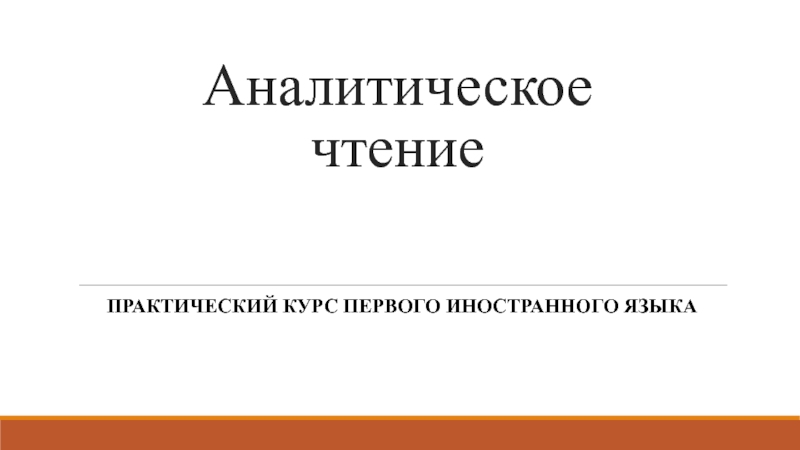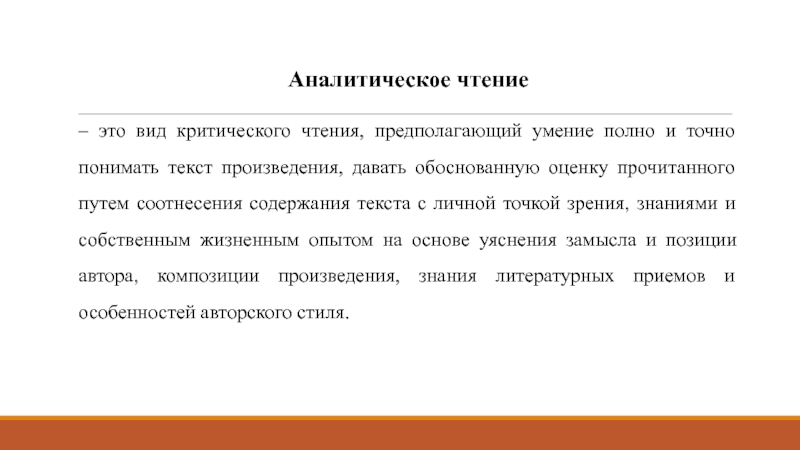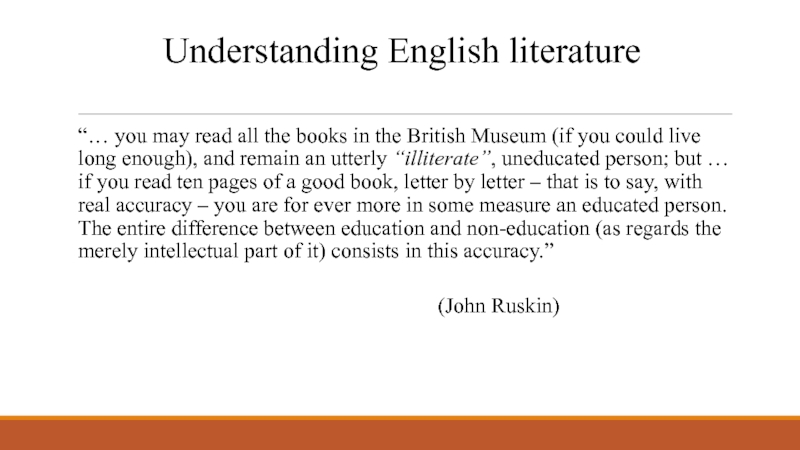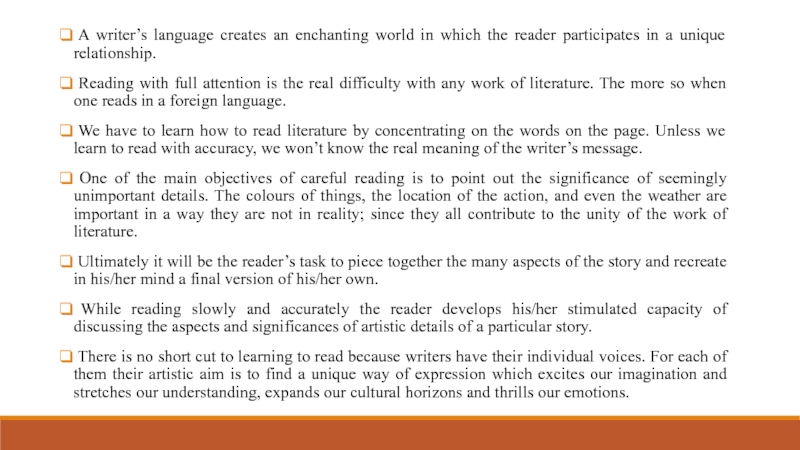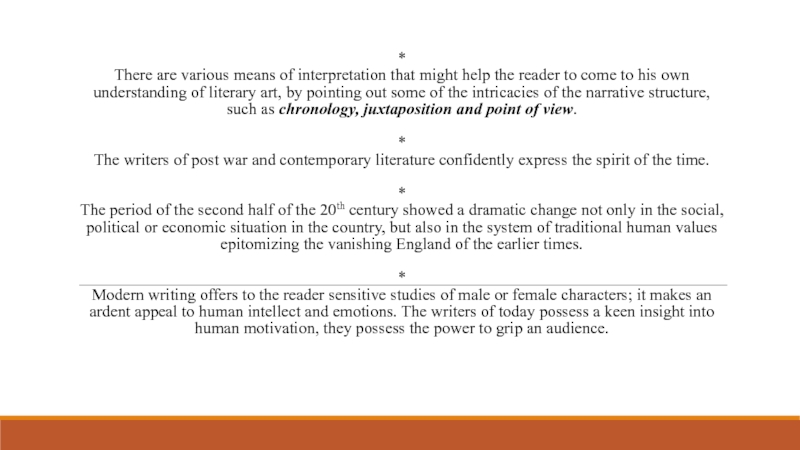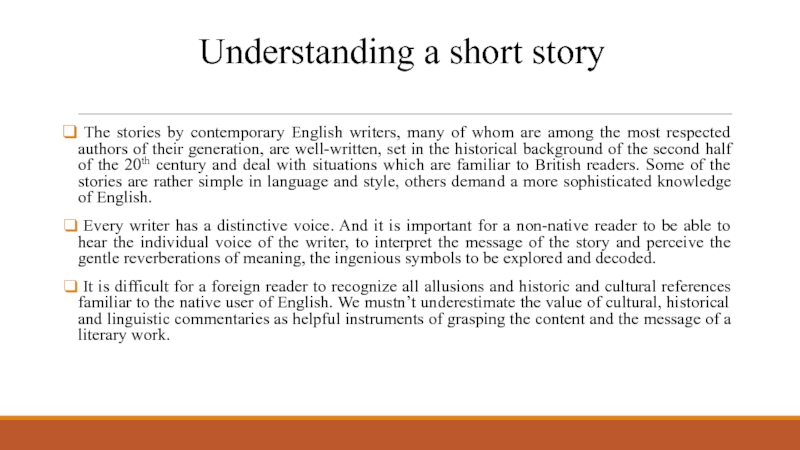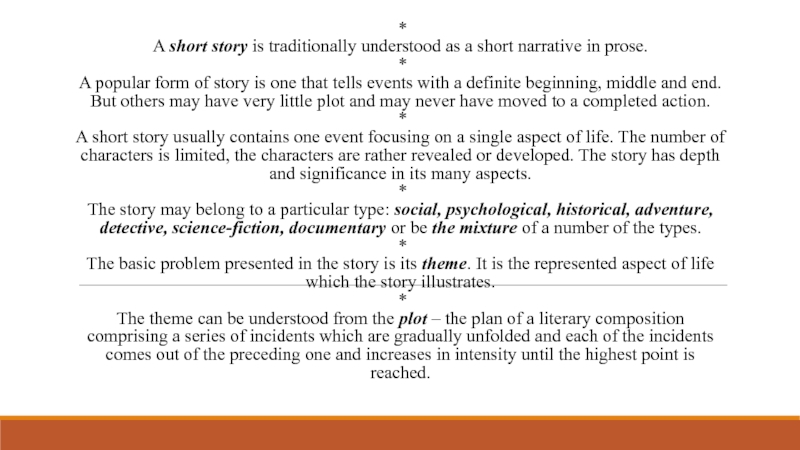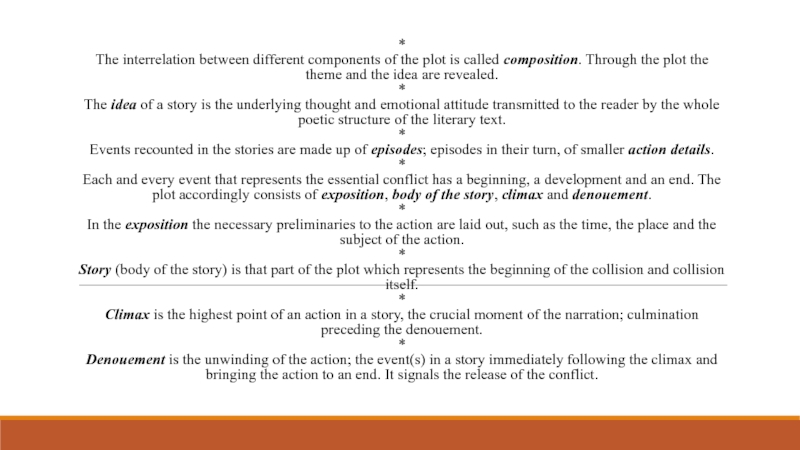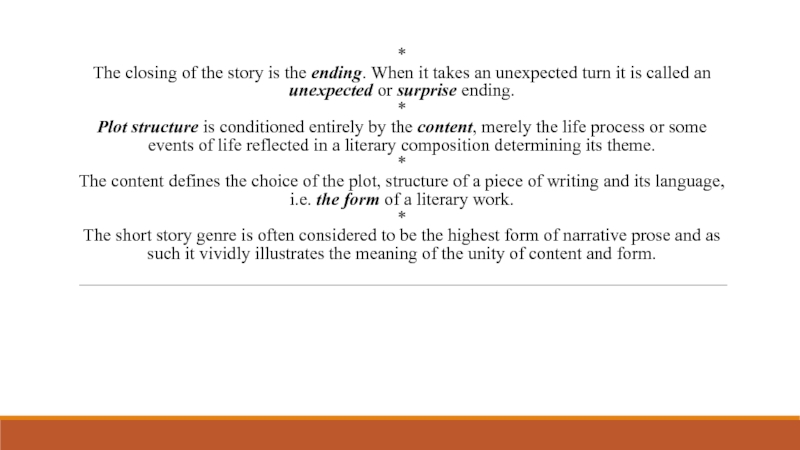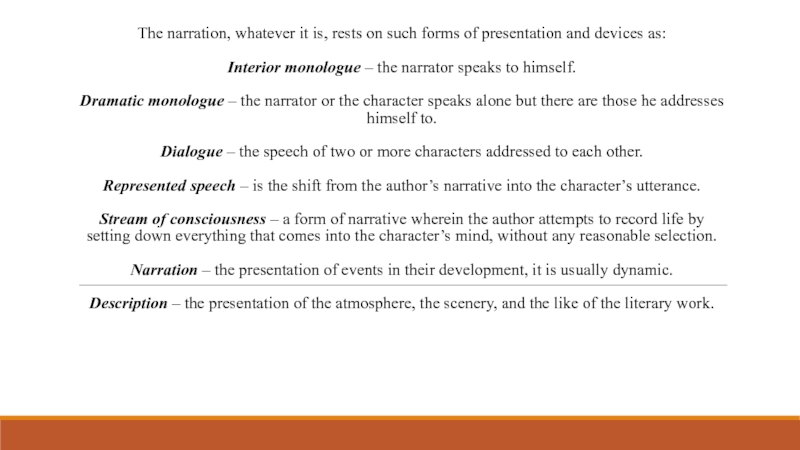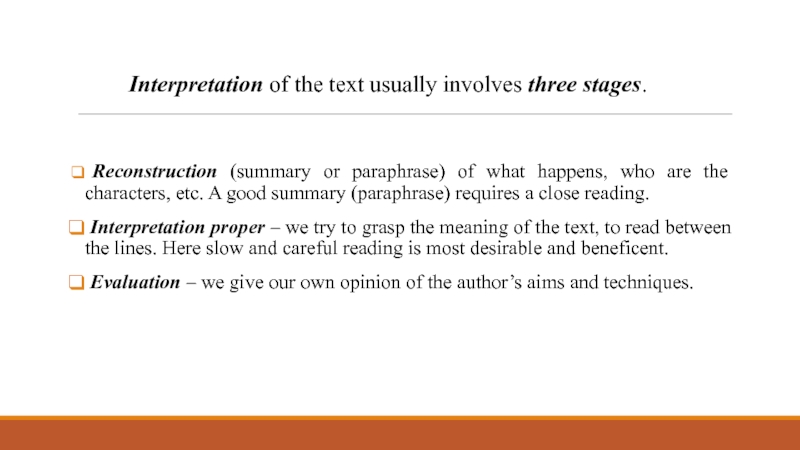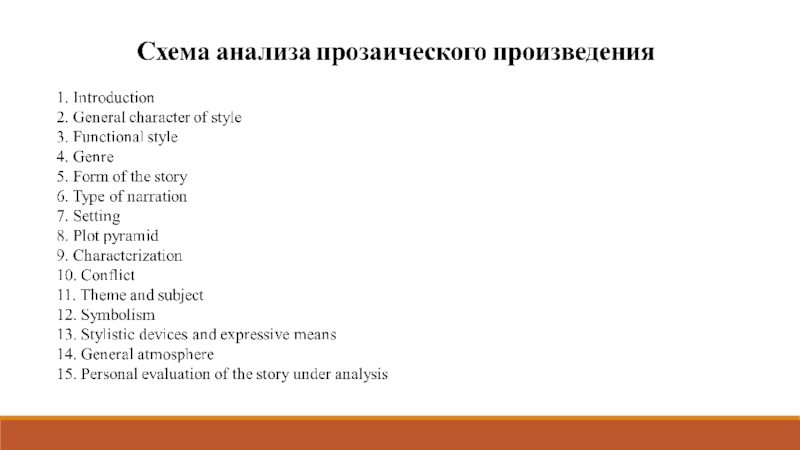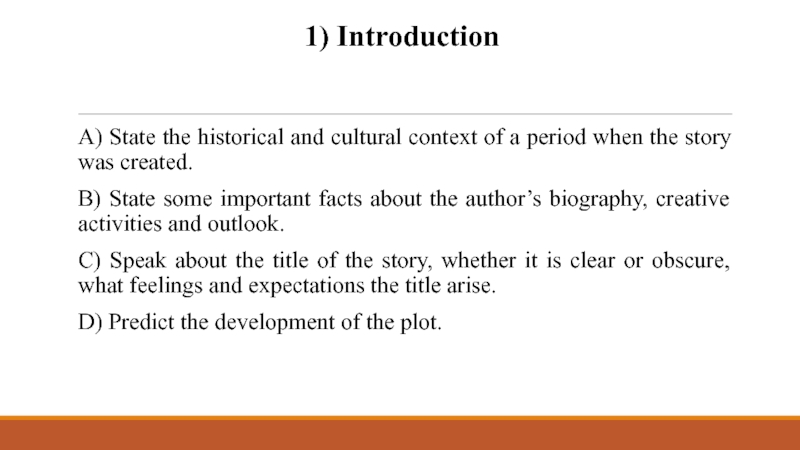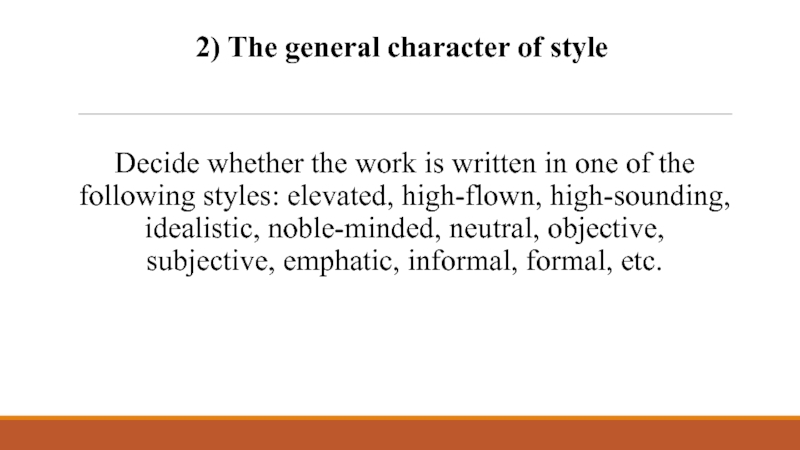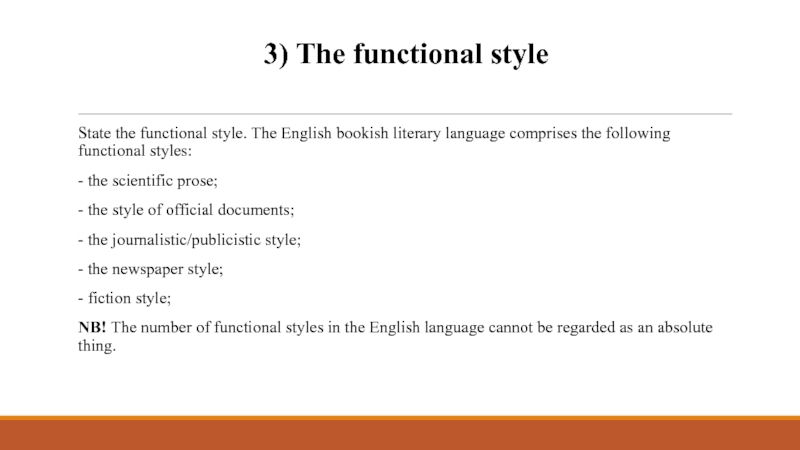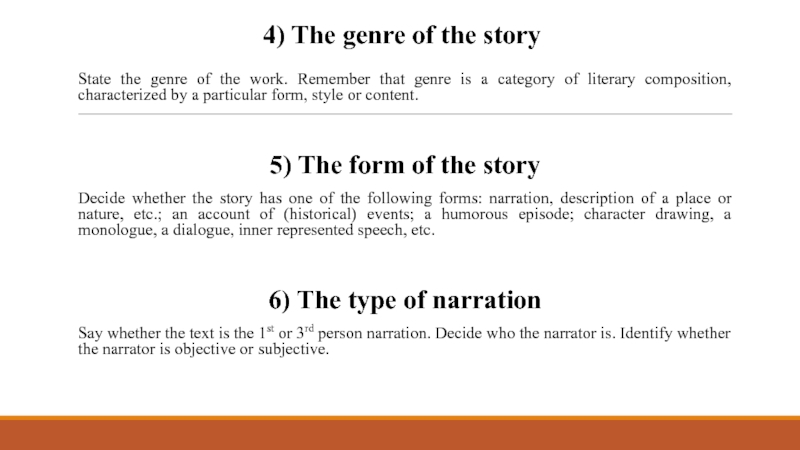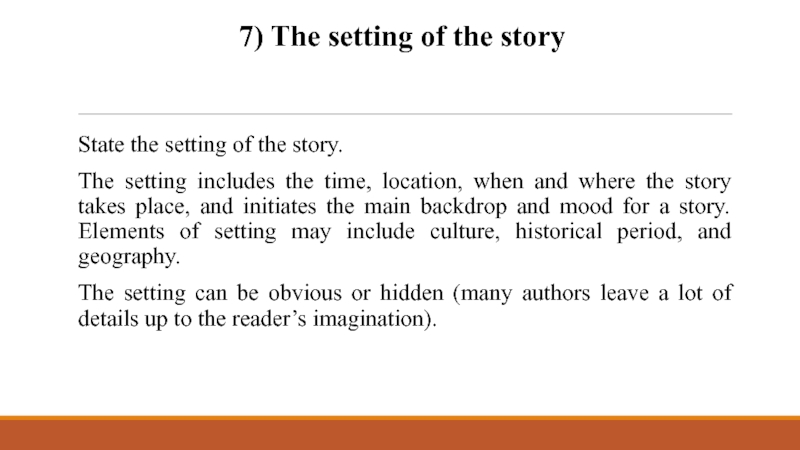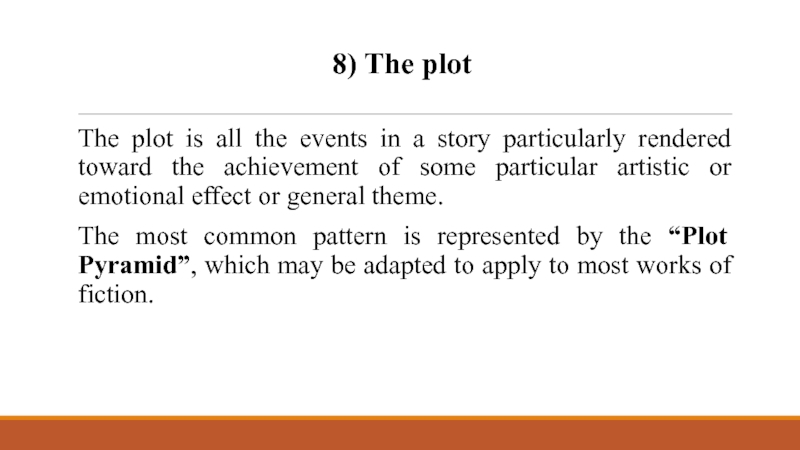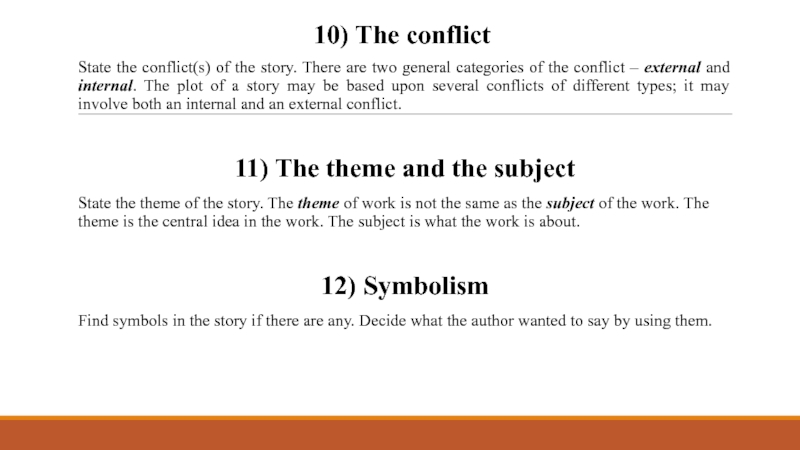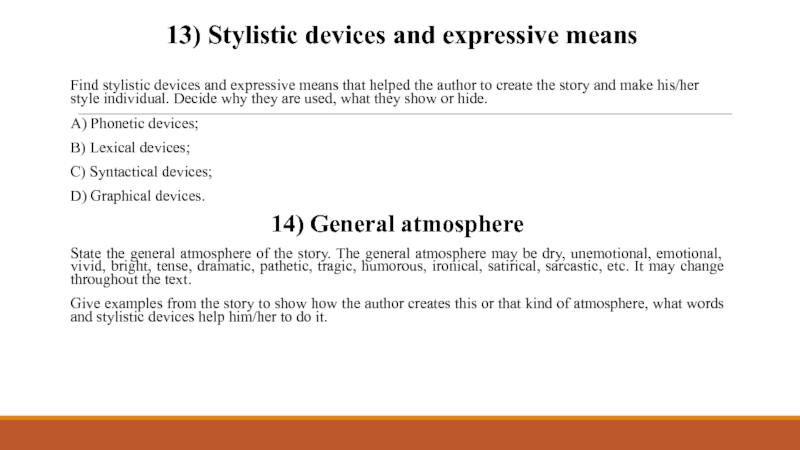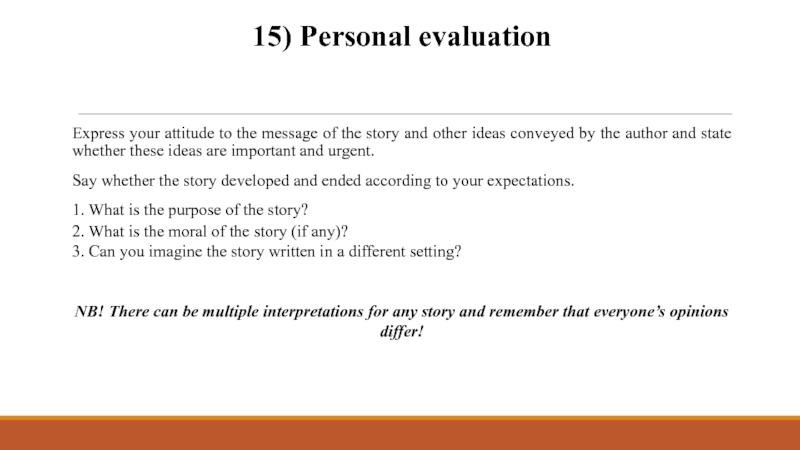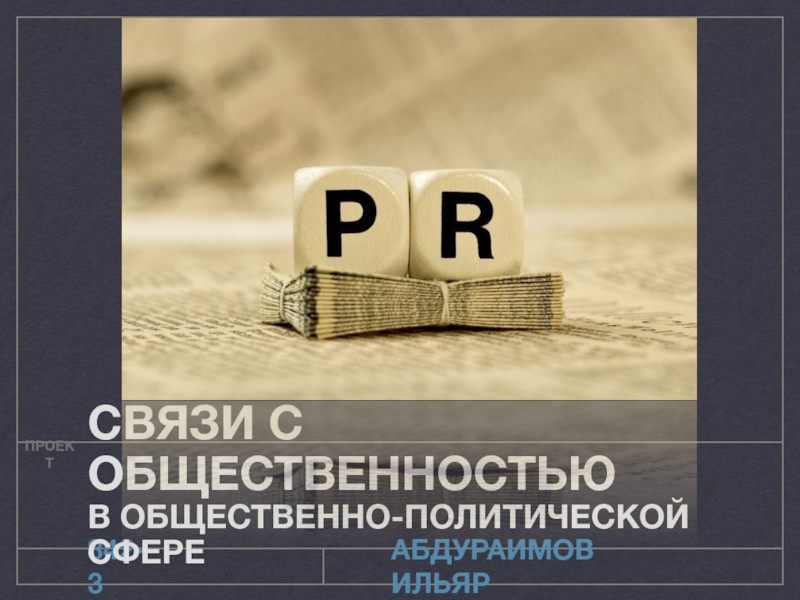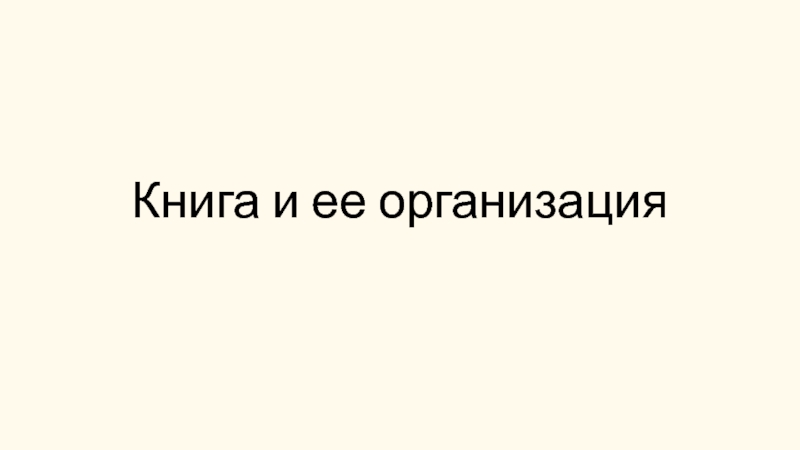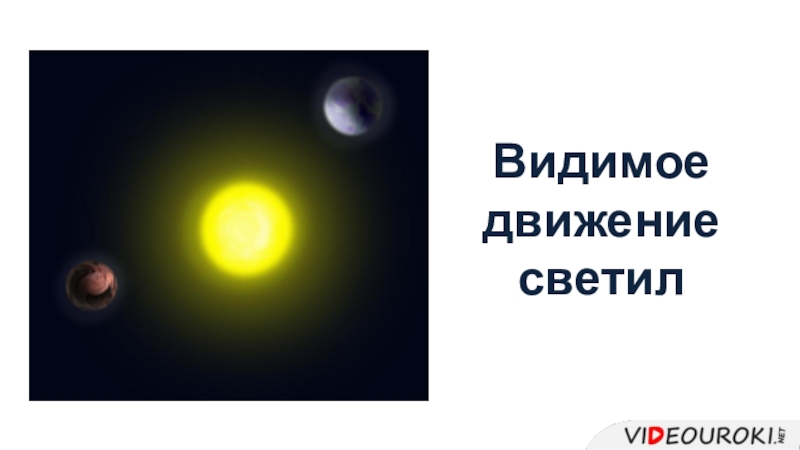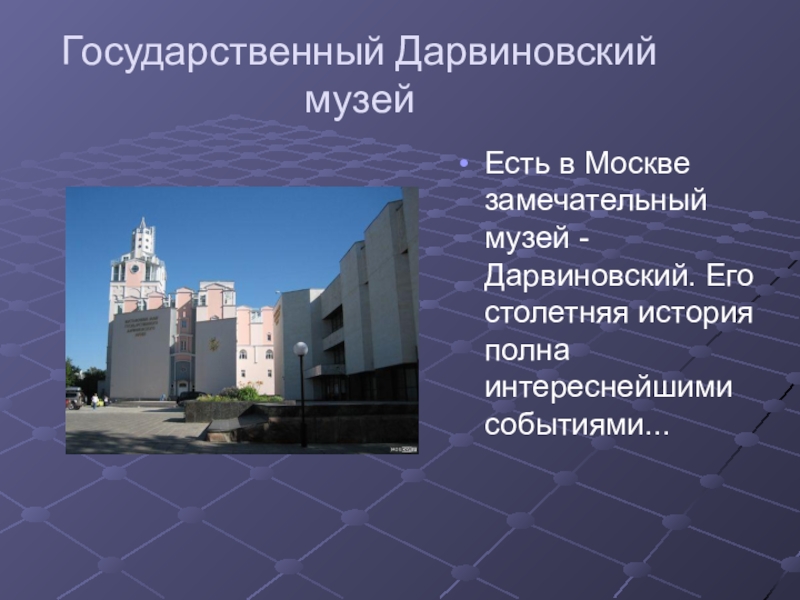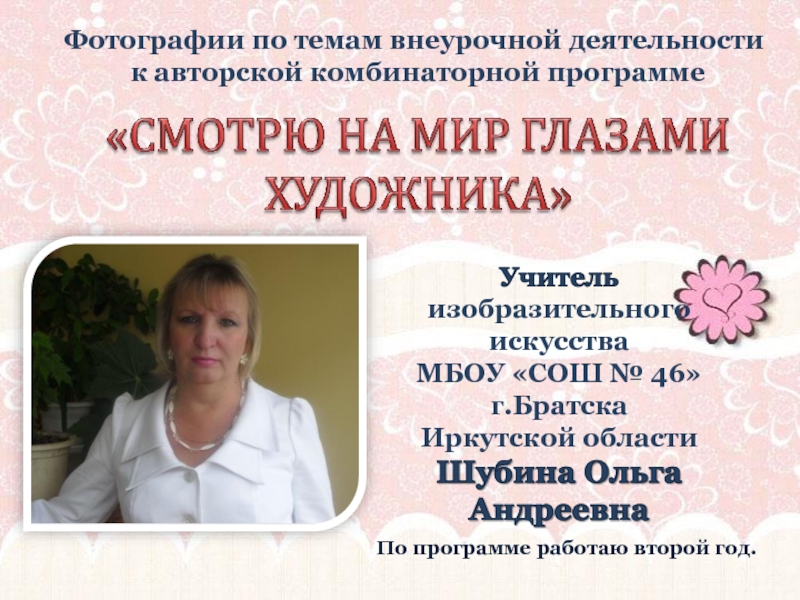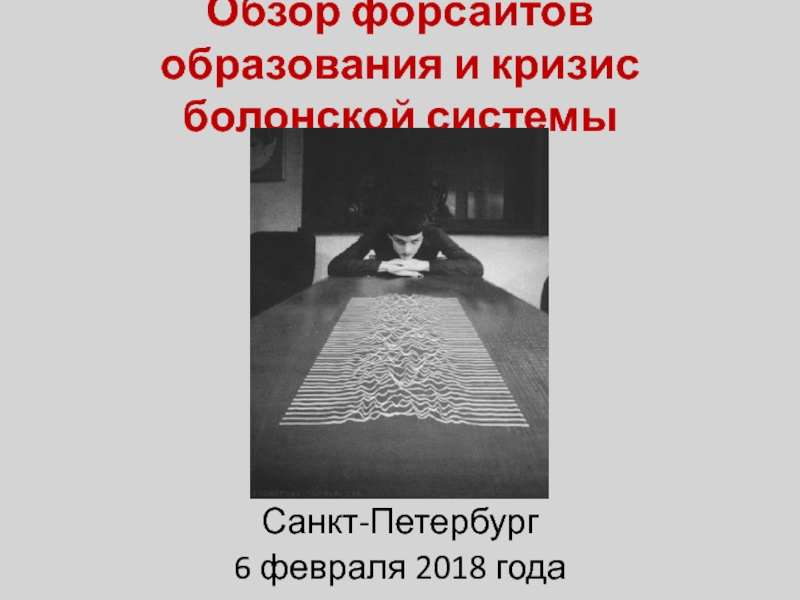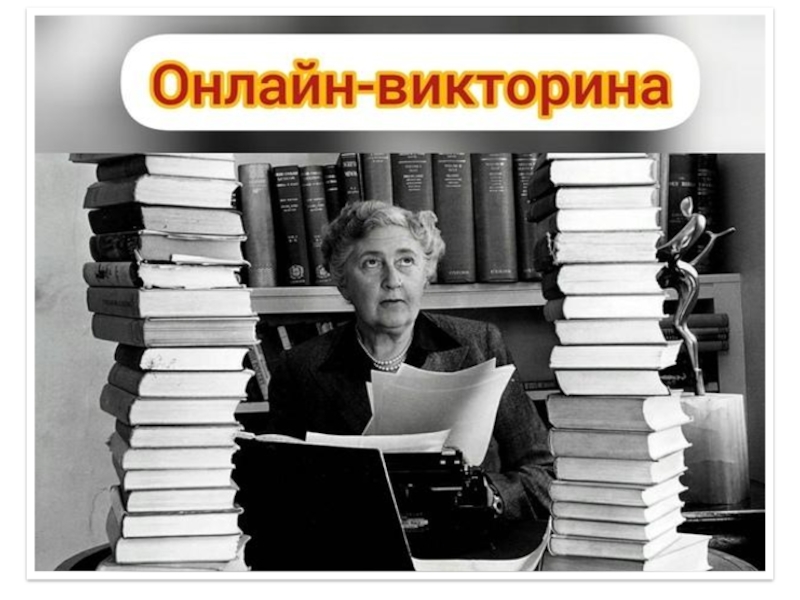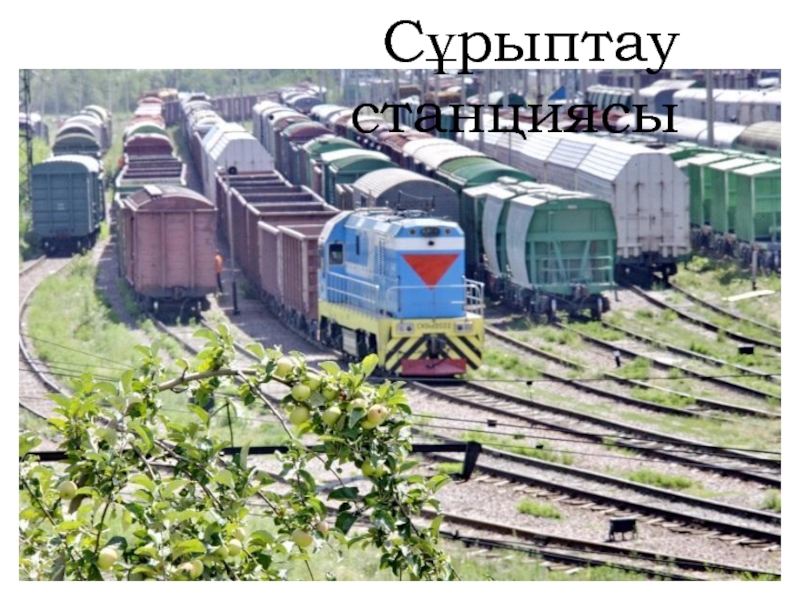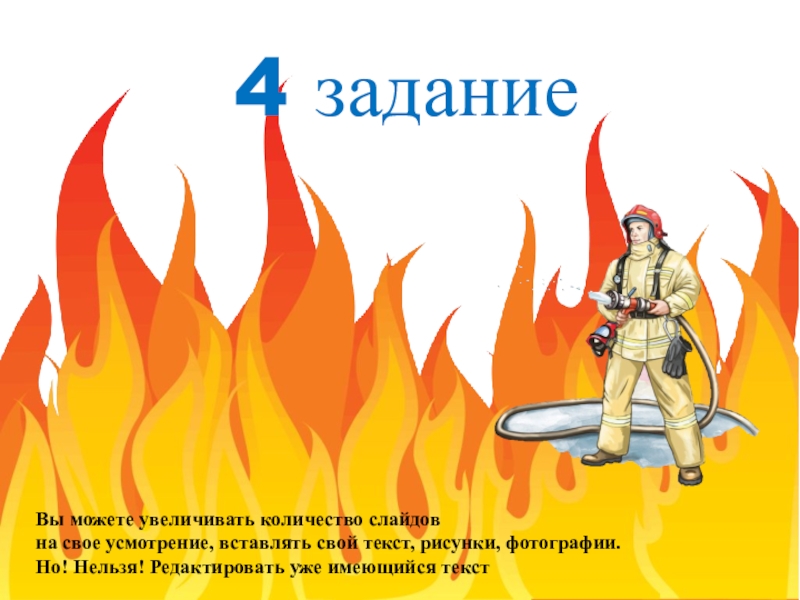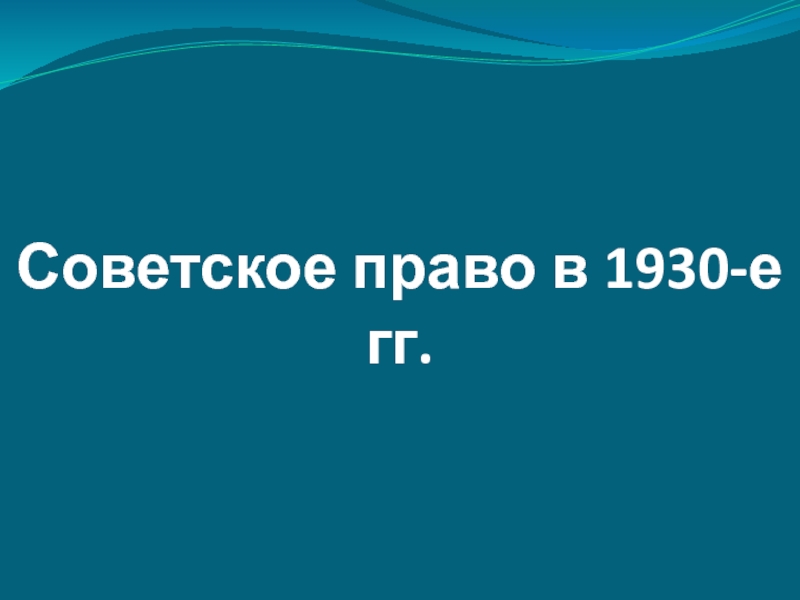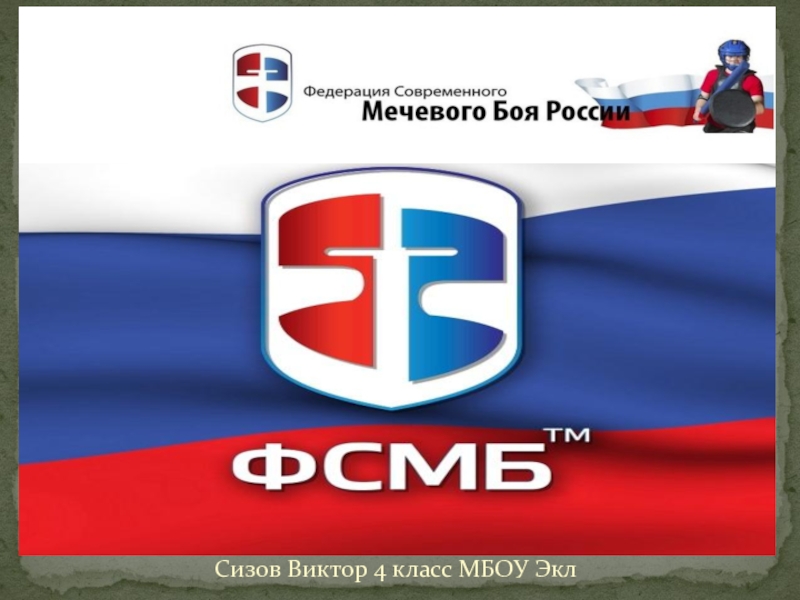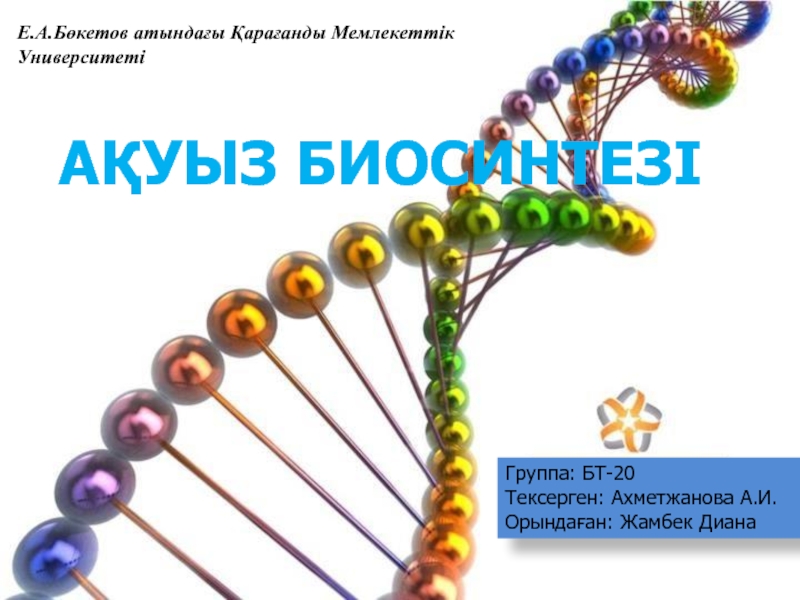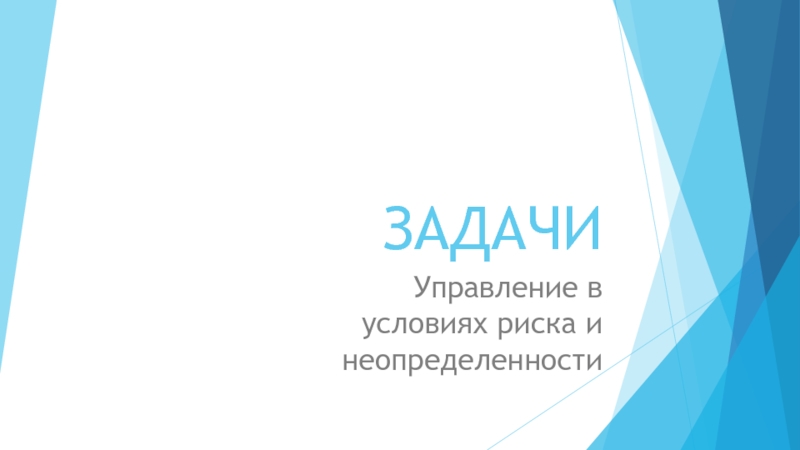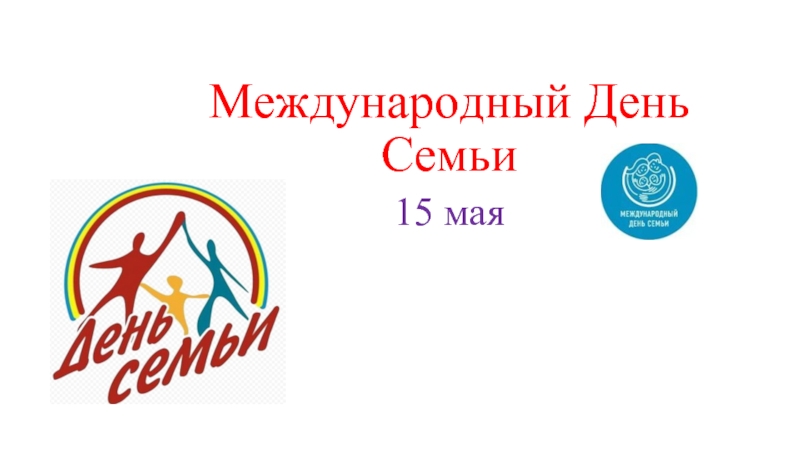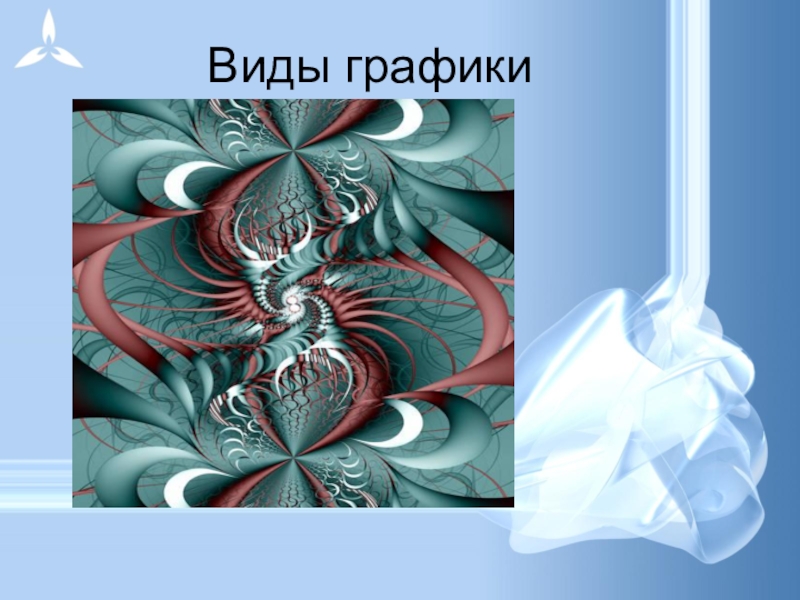Разделы презентаций
- Разное
- Английский язык
- Астрономия
- Алгебра
- Биология
- География
- Геометрия
- Детские презентации
- Информатика
- История
- Литература
- Математика
- Медицина
- Менеджмент
- Музыка
- МХК
- Немецкий язык
- ОБЖ
- Обществознание
- Окружающий мир
- Педагогика
- Русский язык
- Технология
- Физика
- Философия
- Химия
- Шаблоны, картинки для презентаций
- Экология
- Экономика
- Юриспруденция
Аналитическое чтение
Содержание
- 1. Аналитическое чтение
- 2. Аналитическое чтение– это вид критического чтения, предполагающий
- 3. Understanding English literature “… you may read
- 4. A writer’s language creates an enchanting
- 5. * There are various means of interpretation
- 6. Understanding a short story The stories by
- 7. * A short story is traditionally
- 8. * The interrelation between different components of
- 9. * The closing of the story is
- 10. The narration, whatever it is, rests on
- 11. Interpretation of the text usually involves
- 12. Слайд 12
- 13. 1) Introduction A) State the historical and
- 14. 2) The general character of styleDecide whether
- 15. 3) The functional style State the functional
- 16. 4) The genre of the storyState the
- 17. 7) The setting of the story State
- 18. 8) The plot The plot is all
- 19. 9) CharacterizationA) State the main and minor
- 20. 10) The conflict State the conflict(s) of
- 21. 13) Stylistic devices and expressive meansFind stylistic
- 22. 15) Personal evaluation Express your attitude to
- 23. Скачать презентанцию
Аналитическое чтение– это вид критического чтения, предполагающий умение полно и точно понимать текст произведения, давать обоснованную оценку прочитанного путем соотнесения содержания текста с личной точкой зрения, знаниями и собственным жизненным опытом
Слайды и текст этой презентации
Слайд 3Understanding English literature
“… you may read all the books
in the British Museum (if you could live long enough),
and remain an utterly “illiterate”, uneducated person; but … if you read ten pages of a good book, letter by letter – that is to say, with real accuracy – you are for ever more in some measure an educated person. The entire difference between education and non-education (as regards the merely intellectual part of it) consists in this accuracy.”(John Ruskin)
Слайд 4 A writer’s language creates an enchanting world in which
the reader participates in a unique relationship.
Reading with
full attention is the real difficulty with any work of literature. The more so when one reads in a foreign language. We have to learn how to read literature by concentrating on the words on the page. Unless we learn to read with accuracy, we won’t know the real meaning of the writer’s message.
One of the main objectives of careful reading is to point out the significance of seemingly unimportant details. The colours of things, the location of the action, and even the weather are important in a way they are not in reality; since they all contribute to the unity of the work of literature.
Ultimately it will be the reader’s task to piece together the many aspects of the story and recreate in his/her mind a final version of his/her own.
While reading slowly and accurately the reader develops his/her stimulated capacity of discussing the aspects and significances of artistic details of a particular story.
There is no short cut to learning to read because writers have their individual voices. For each of them their artistic aim is to find a unique way of expression which excites our imagination and stretches our understanding, expands our cultural horizons and thrills our emotions.
Слайд 5* There are various means of interpretation that might help the
reader to come to his own understanding of literary art,
by pointing out some of the intricacies of the narrative structure, such as chronology, juxtaposition and point of view. * The writers of post war and contemporary literature confidently express the spirit of the time. * The period of the second half of the 20th century showed a dramatic change not only in the social, political or economic situation in the country, but also in the system of traditional human values epitomizing the vanishing England of the earlier times. * Modern writing offers to the reader sensitive studies of male or female characters; it makes an ardent appeal to human intellect and emotions. The writers of today possess a keen insight into human motivation, they possess the power to grip an audience.Слайд 6Understanding a short story
The stories by contemporary English writers,
many of whom are among the most respected authors of
their generation, are well-written, set in the historical background of the second half of the 20th century and deal with situations which are familiar to British readers. Some of the stories are rather simple in language and style, others demand a more sophisticated knowledge of English.Every writer has a distinctive voice. And it is important for a non-native reader to be able to hear the individual voice of the writer, to interpret the message of the story and perceive the gentle reverberations of meaning, the ingenious symbols to be explored and decoded.
It is difficult for a foreign reader to recognize all allusions and historic and cultural references familiar to the native user of English. We mustn’t underestimate the value of cultural, historical and linguistic commentaries as helpful instruments of grasping the content and the message of a literary work.
Слайд 7 * A short story is traditionally understood as a short
narrative in prose. * A popular form of story is
one that tells events with a definite beginning, middle and end. But others may have very little plot and may never have moved to a completed action. * A short story usually contains one event focusing on a single aspect of life. The number of characters is limited, the characters are rather revealed or developed. The story has depth and significance in its many aspects. * The story may belong to a particular type: social, psychological, historical, adventure, detective, science-fiction, documentary or be the mixture of a number of the types. * The basic problem presented in the story is its theme. It is the represented aspect of life which the story illustrates. * The theme can be understood from the plot – the plan of a literary composition comprising a series of incidents which are gradually unfolded and each of the incidents comes out of the preceding one and increases in intensity until the highest point is reached.Слайд 8* The interrelation between different components of the plot is called
composition. Through the plot the theme and the idea are
revealed. * The idea of a story is the underlying thought and emotional attitude transmitted to the reader by the whole poetic structure of the literary text. * Events recounted in the stories are made up of episodes; episodes in their turn, of smaller action details. * Each and every event that represents the essential conflict has a beginning, a development and an end. The plot accordingly consists of exposition, body of the story, climax and denouement. * In the exposition the necessary preliminaries to the action are laid out, such as the time, the place and the subject of the action. * Story (body of the story) is that part of the plot which represents the beginning of the collision and collision itself. * Climax is the highest point of an action in a story, the crucial moment of the narration; culmination preceding the denouement. * Denouement is the unwinding of the action; the event(s) in a story immediately following the climax and bringing the action to an end. It signals the release of the conflict.Слайд 9* The closing of the story is the ending. When it
takes an unexpected turn it is called an unexpected or
surprise ending. * Plot structure is conditioned entirely by the content, merely the life process or some events of life reflected in a literary composition determining its theme. * The content defines the choice of the plot, structure of a piece of writing and its language, i.e. the form of a literary work. * The short story genre is often considered to be the highest form of narrative prose and as such it vividly illustrates the meaning of the unity of content and form.Слайд 10The narration, whatever it is, rests on such forms of
presentation and devices as: Interior monologue – the narrator speaks to
himself. Dramatic monologue – the narrator or the character speaks alone but there are those he addresses himself to. Dialogue – the speech of two or more characters addressed to each other. Represented speech – is the shift from the author’s narrative into the character’s utterance. Stream of consciousness – a form of narrative wherein the author attempts to record life by setting down everything that comes into the character’s mind, without any reasonable selection. Narration – the presentation of events in their development, it is usually dynamic. Description – the presentation of the atmosphere, the scenery, and the like of the literary work.Слайд 11
Interpretation of the text usually involves three stages.
Reconstruction (summary
or paraphrase) of what happens, who are the characters, etc.
A good summary (paraphrase) requires a close reading.Interpretation proper – we try to grasp the meaning of the text, to read between the lines. Here slow and careful reading is most desirable and beneficent.
Evaluation – we give our own opinion of the author’s aims and techniques.
Слайд 131) Introduction
A) State the historical and cultural context of
a period when the story was created.
B) State some important
facts about the author’s biography, creative activities and outlook. C) Speak about the title of the story, whether it is clear or obscure, what feelings and expectations the title arise.
D) Predict the development of the plot.
Слайд 142) The general character of style
Decide whether the work is
written in one of the following styles: elevated, high-flown, high-sounding,
idealistic, noble-minded, neutral, objective, subjective, emphatic, informal, formal, etc.Слайд 153) The functional style
State the functional style. The English
bookish literary language comprises the following functional styles:
- the scientific
prose;- the style of official documents;
- the journalistic/publicistic style;
- the newspaper style;
- fiction style;
NB! The number of functional styles in the English language cannot be regarded as an absolute thing.
Слайд 164) The genre of the story
State the genre of the
work. Remember that genre is a category of literary composition,
characterized by a particular form, style or content.5) The form of the story
Decide whether the story has one of the following forms: narration, description of a place or nature, etc.; an account of (historical) events; a humorous episode; character drawing, a monologue, a dialogue, inner represented speech, etc.
6) The type of narration
Say whether the text is the 1st or 3rd person narration. Decide who the narrator is. Identify whether the narrator is objective or subjective.
Слайд 177) The setting of the story
State the setting of
the story.
The setting includes the time, location, when and
where the story takes place, and initiates the main backdrop and mood for a story. Elements of setting may include culture, historical period, and geography. The setting can be obvious or hidden (many authors leave a lot of details up to the reader’s imagination).
Слайд 188) The plot
The plot is all the events in
a story particularly rendered toward the achievement of some particular
artistic or emotional effect or general theme.The most common pattern is represented by the “Plot Pyramid”, which may be adapted to apply to most works of fiction.
Слайд 199) Characterization
A) State the main and minor characters of the
story. There are two broad categories of character development –
simple and complex.Simple (flat) characters have only one or two personality traits and are easily recognizable as stereotypes.
Complex (round) characters have multiple personality traits and therefore resemble real people. They are harder to understand and describe.
B) State how the characters are revealed. Authors reveal what characters are like in two general ways – directly and indirectly.
Слайд 2010) The conflict
State the conflict(s) of the story. There
are two general categories of the conflict – external and
internal. The plot of a story may be based upon several conflicts of different types; it may involve both an internal and an external conflict.11) The theme and the subject
State the theme of the story. The theme of work is not the same as the subject of the work. The theme is the central idea in the work. The subject is what the work is about.
12) Symbolism
Find symbols in the story if there are any. Decide what the author wanted to say by using them.
Слайд 2113) Stylistic devices and expressive means
Find stylistic devices and expressive
means that helped the author to create the story and
make his/her style individual. Decide why they are used, what they show or hide.A) Phonetic devices;
B) Lexical devices;
C) Syntactical devices;
D) Graphical devices.
14) General atmosphere
State the general atmosphere of the story. The general atmosphere may be dry, unemotional, emotional, vivid, bright, tense, dramatic, pathetic, tragic, humorous, ironical, satirical, sarcastic, etc. It may change throughout the text.
Give examples from the story to show how the author creates this or that kind of atmosphere, what words and stylistic devices help him/her to do it.
Слайд 2215) Personal evaluation
Express your attitude to the message of
the story and other ideas conveyed by the author and
state whether these ideas are important and urgent.Say whether the story developed and ended according to your expectations.
1. What is the purpose of the story?
2. What is the moral of the story (if any)?
3. Can you imagine the story written in a different setting?
NB! There can be multiple interpretations for any story and remember that everyone’s opinions differ!
